![]()
![]()
The foundation of the city Odessa
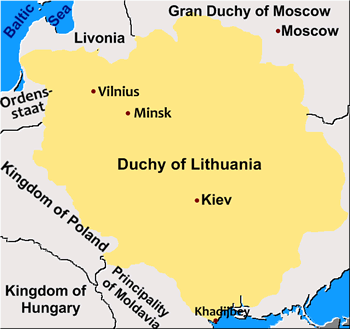
position of Khadijbey in the Duchy of Lithuania
Where Odessa is today, once, in 1240, was the Tatar settlement Khadjibey1 (literal translation: "The prince, who visited Mecca").
In the 14th century the territory on the Black Sea was under the sphere of influence of the Grand Duchy of Lithuania.
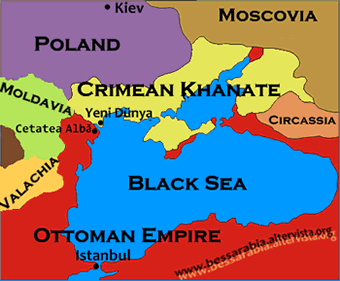
position of Yeni Dünya in the 16th century
From 1529 this area was invaded and occupied by Ottomans and was assigned to the Crimean Khanate. In 1765, near the earlier settlement of Khadjibey, the Ottoman fortress Yeni Dünya or Jeni-Dunia was built (from the Ottoman “New World”).
The fortress was conquered by Russians in the Russian-Turkish war (1787-1792) and thus became part of New Russia.
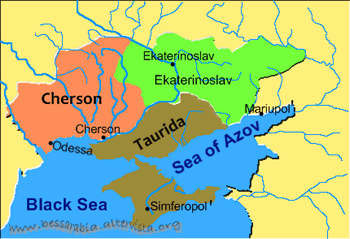
New Russia
Catherine II, then ruler of Russia, wanted a port on the Black Sea that could ease relations and trade with Europe. In 1794 she issued a ukase which ordered the building of a seaport, in the vicinity of the fortress Yeni Dünya, on the newly acquired territory and, in 1795, it received the name “Odessa”.
In 1803 Odessa looked more like a village than a city, with only 4.000 inhabitants and a few small dirt huts scattered around the land.
Odessa became the homeland to many ethnic groups: Ukrainians, Russians, Jews, Poles, Romanians, Greeks, Bulgarians, Albanians, Armenians, Italians, French, German (including Mennonites1), and merchants from many other countries.
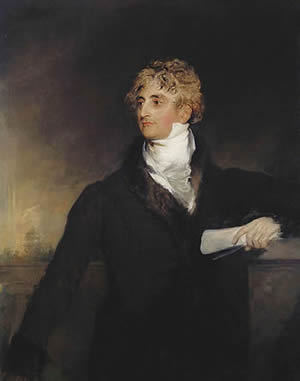
Duke Richelieu
When the second appointed governor of New Russia, Duke Armand de Richelieu3, a French immigrant, arrived in the city, he noticed a great shortag of craftsmen.
Apparently, after his arrival, he couldn't find within two weeks a couple of easy chairs and had to demand a carpenter, a baker and a locksmith from the trade minister from St. Petersburg.
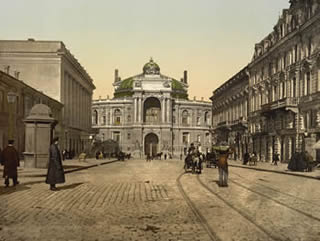
Richelieu Street and opera house in Odessa 1890
Against this condition he acted vigorously and, of the people who settled in Odessa in 1803, 42 individuals and their families were immediately assigned to craftsmen. They formed a craftsmen colony that in the early development of Odessa had a significant impact.
Under Richelieu's administration Odessa quickly grew into a metropolis of South Russia. By 1817 through to 1859, Odessa became a free port and the fourth-biggest city in the Russian Empire after Moscow, St. Petersburg and Warsaw. The harvesting of cereals developed rapidly and, already by 1822, it represented 96% of the Russian grain export. By 1868 the wheat cultivation had become dominant for the economy as it was 89% of the colony’s income. Soon also developed a lively religious community.
Since 1819 the city established itself as an important commercial centre and a transit port between Europe and Asia. During the Crimean War (1853-1856) the city was heavily hit by the British and French Navy bombardments. Then after, Odessa began to grow again and developed into the main Russian port for grain export.
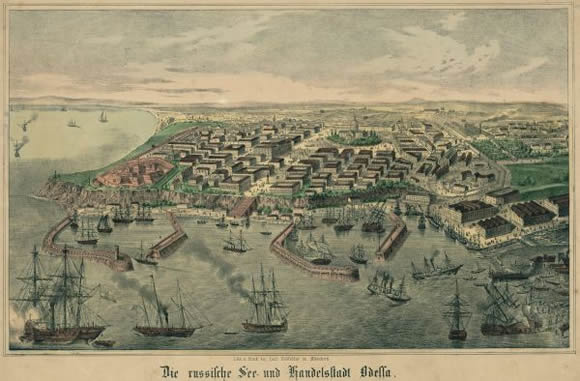
Odessa about 1850
Welfare office for settlers in New Russia
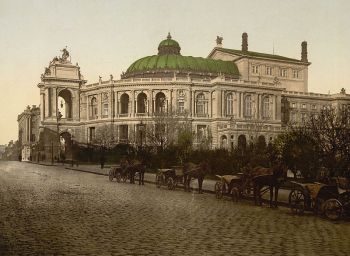
opera house of Odessa
Between 1803 and 1818 in Odessa was established a welfare office for settlers in New Russia. In 1818 it was responsible for approximately 15,500 non-Russian settlers. This included the German settlements located northwest of the Black Sea with the 4 districts of: Großliebental, Beresan, Kutschurgan and Glückstal and several individual German villages, and the Bulgarian and Greek districts: Ternovka, Buyalik and Parkani. In addition it also managed, four Swedish, nine Jewish and the Serbian village Zetin. After 1818, the firm to a regional branch of the welfare committee for foreign settlers in Kherson. It was then closed in 1833.
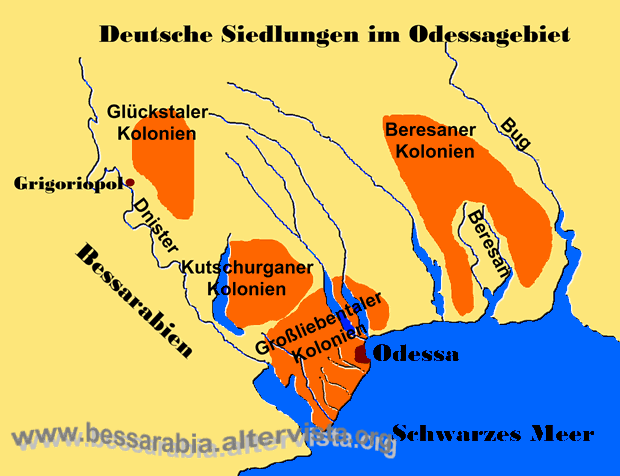
German settlements in the Odessa area
During the World War II Odessa was occupied by the Romanian and German troops from 1941 to 1944. Since December 1941 the city was the official Romanian general headquarters of Transnistria. During the occupation period approximately 60,000 people were murdered or deported, most of them were Jew.

location of Odessa today
Today, the city of Odessa (Ukrainian Одеса; Russian Одесса) belongs to Ukraine. It is the capital of the region of Odessa, has a population 1.03 million and is the most important port city on the Black Sea. The historic architecture of the city has more of a Mediterranean than a Russian feel, which was influenced greatly by the French and Italian styles.
1 Kadjibey = also known as: Cadjnabei, Khadjibei, Khacdjibei, Hacıbey, Hocabey or Gadzhibei in Turkish, Lithuanian: Chadžibėjus; Crimean Tatar: Hacıbey
2 Mennonites = follower of a Free Evangelical Church, which originated in Switzerland and the Netherlands at the time of the Protestant Reformation. They use adult baptism, refuse military duty and the act of taking an oath. They where named after the religious leader Menno Simons (1496-1561), priest of the sixteenth century that ensured the survival of Mennonites after this group experienced a period of serious crisis.
3 Armand-Emmanuel du Plessis, Duc de Richelieu (* 25 September 1766 in Paris; † 17 May 1822) was a prominent French statesman, diplomat and royalist. He was the son of Louis Antoine du Plessis, duc de Fronsac and grandson of King Louis XV of France's favorite, the Maréchal de Richelieu who was a great-greatson of cardinal Richelieu.
In 1790 the queen Marie Antoinette ordered him to go to Vienna to discuss the recent events of the French Revolution with her elder brother, the Holy Roman Emperor and ruler of the Habsburg lands Joseph II. However, Richelieu couldn't speak with his brother because he died before he arrived.
Richelieu still remained at Vienna. For his stay abroad Richielieu was writing to the list of émigrées (French term given to the royalist and Protestant fugitives who fled during the revolution of 1789).
Later he signed on with the Russian Army and participated in the taking of Izmail, receiving by the Empress Catherine II the Cross of the Order of St. George and a gold sword.
Czar Alexander I, Catherine II's successor, for the brief interlude of Paul I, he offered to émigrées officer jobs in the army. Richelieu agreed, reaching the flattering rank to Major General. At the Russian government's request his name has been deleted the emigrants' list.
In 1803 he became governor of Odessa and gave effective help to the German immigrants. In 1805 he became general governor of New Russia (Cherson, Jekaterinoslav, Crimea).




